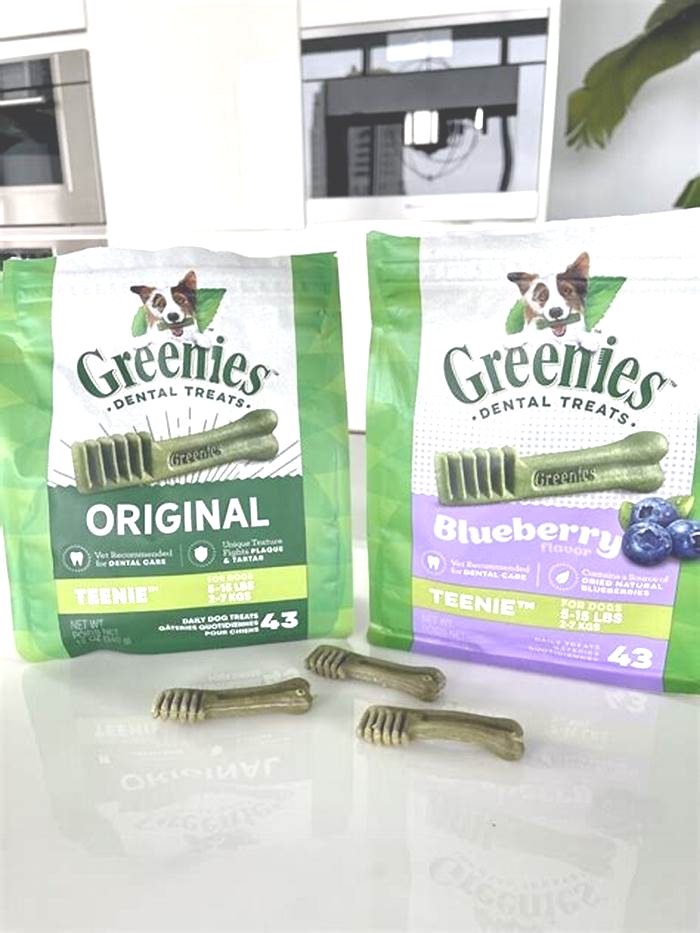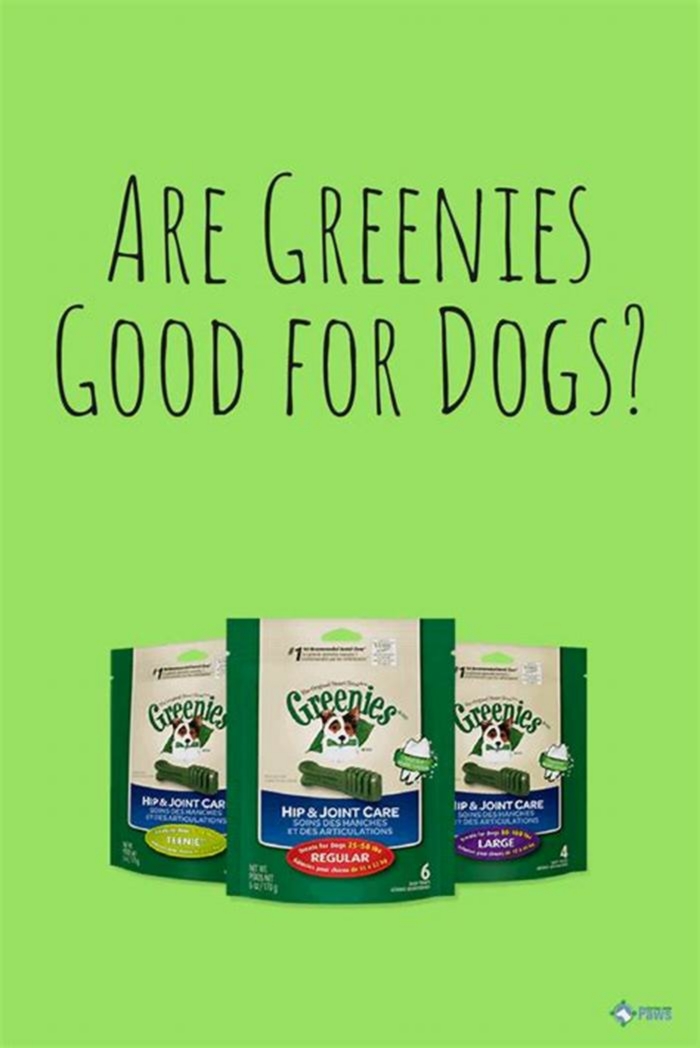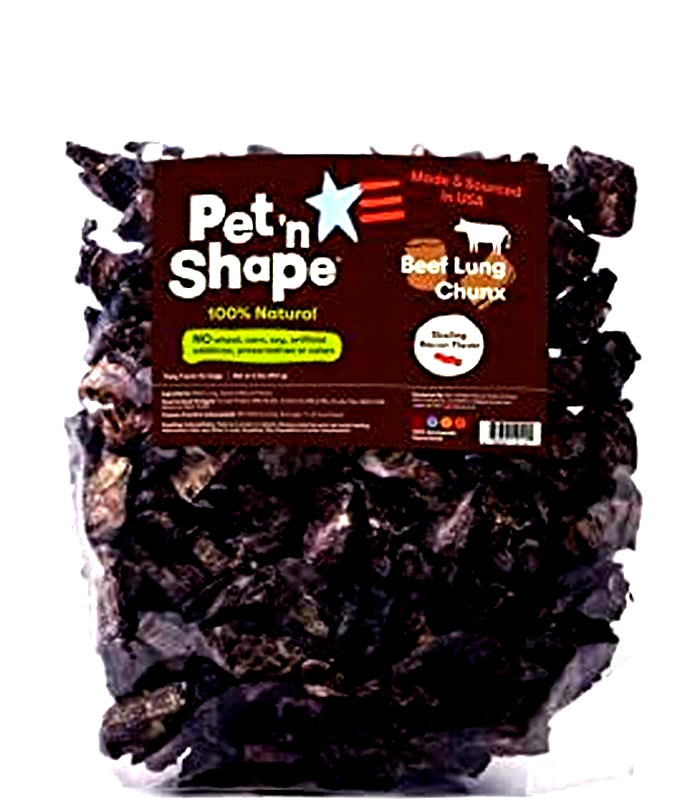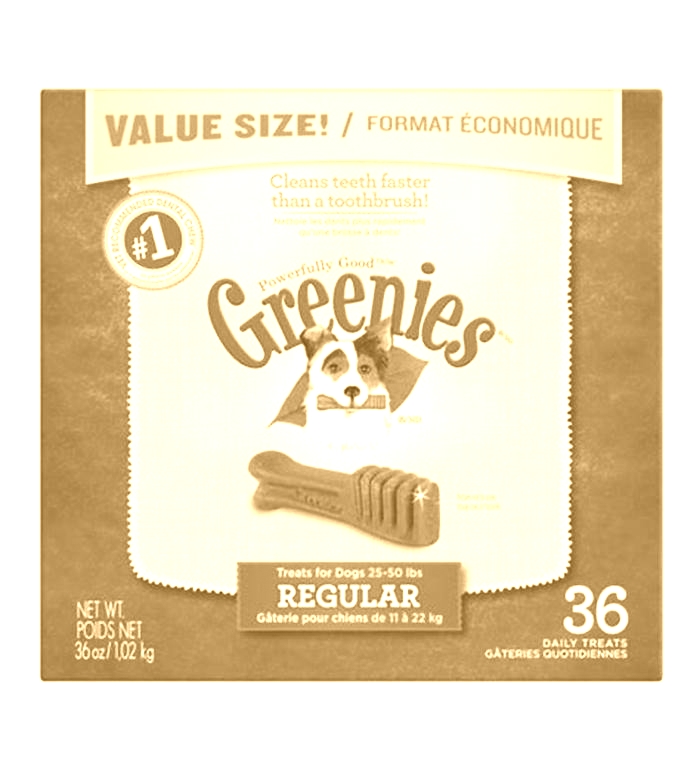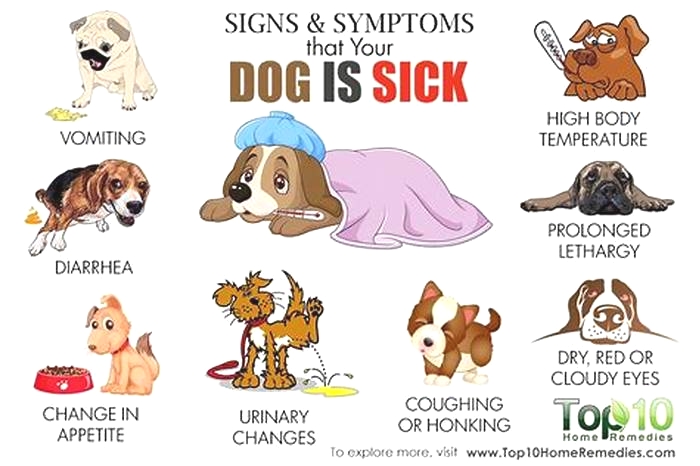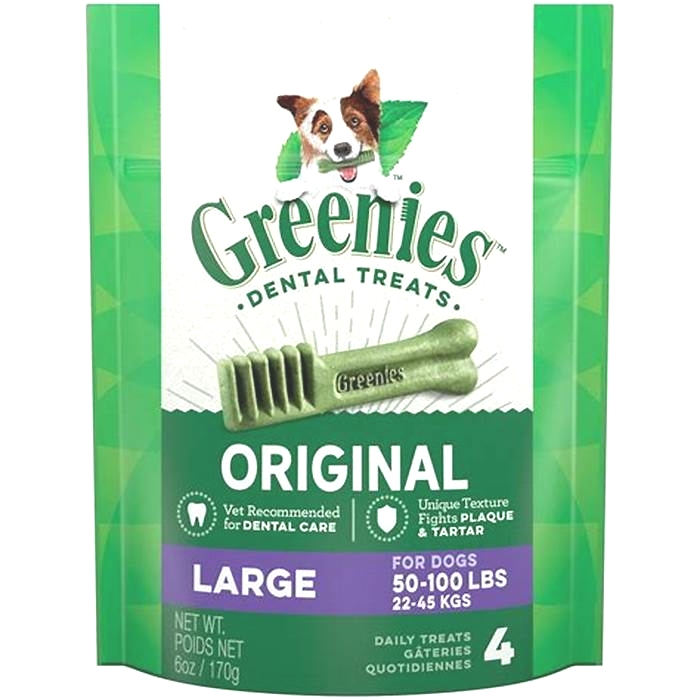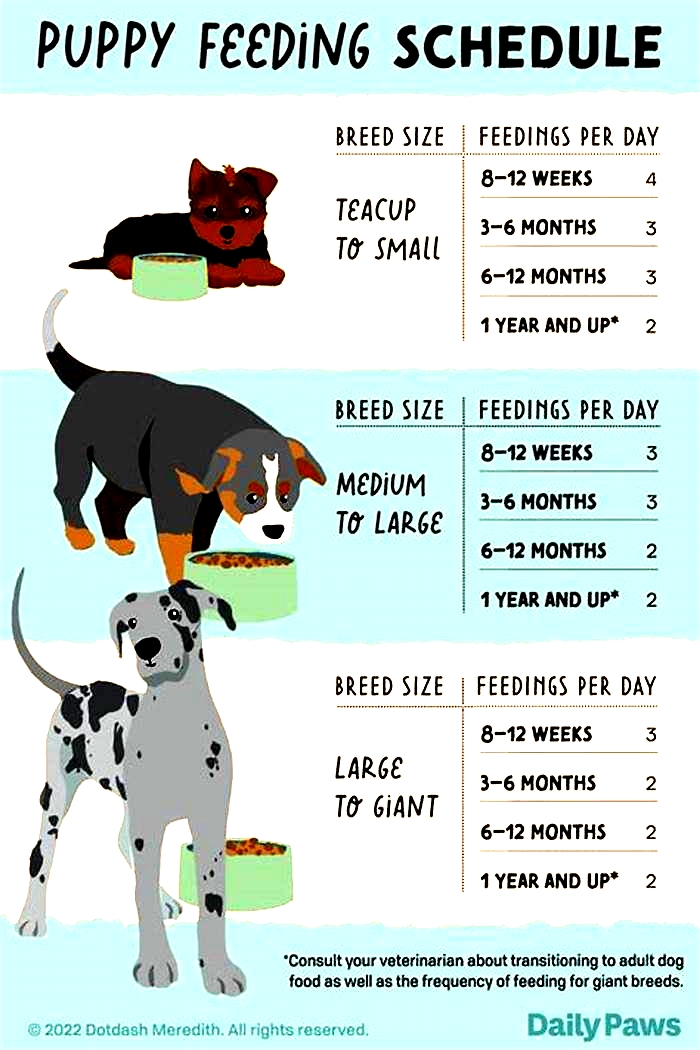Are greenies bad for dogs
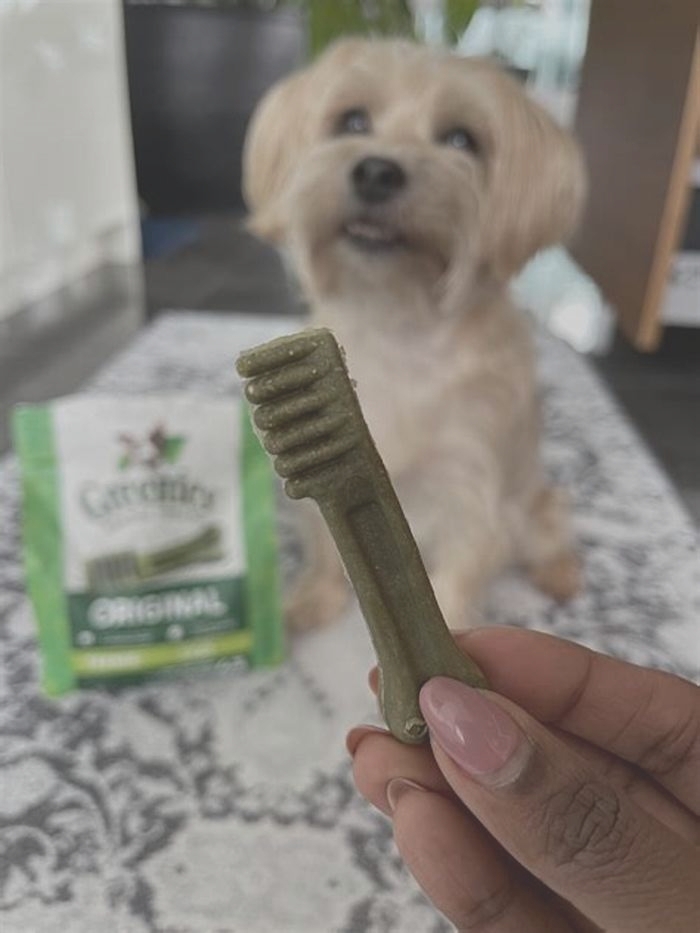
Greenies Dog Treats Are Actually BAD For Your Dog
This post may contain affiliate links. If you click and buy something that I recommend, I might receive a small commission.

If you are a dog owner, then you are probably familiar with Greenies for dogs, the green toothbrush-shaped dental chews found in most big-box pet retailers like Petsmart and Petco.
Greenies for dogs is one of the most popular dental treat brands.
But, should they be so popular? Is their product really that great, or is it a result of clever marketing and packaging?
What if I told you giving your dog Greenies dog treats for dental care, is actually doing more harm than good?
Greenies & Dog Dental Care
The main reason why pet parents purchase Greenies dental chews is for the dental care benefits that Greenies boasts their product provides.
On their website, Greenies.com states:
Dental treats or dental chews work with mechanical action similar to how your toothbrush works, where it will scrape the surface of the tooth and help brush away plaque and tartar that can accumulate that can lead to more serious problems.
Greenies.com
This entire statement focuses on the benefits of chewing, but fails to address the most important topic What is your dog actually chewing on.
Greenies also brag about their seal of approval from The Veterinary Oral Health Council.
However, on the first page of VOHCs website, they state:
When VOHC authorizes the use of its Registered Seal, VOHC makes no certification, representation or warranty as to the safety and certifies only that, upon application for the right to use the Registered Seal, the product met VOHCs Standards for effectiveness in retarding plaque and tartar when used as directed.
VOHC Website
There is no denying that chewing or gnawing has proven to be an effective method for keeping a dogs teeth clean, gums healthy, and freshen breath.
However, it is important to understand that dogs are consuming what they are chewing on.
So yes, chewing on say, a shoe, may be beneficial for your dogs teeth and gum health, but that doesnt mean it is healthy for your dog to be consuming shoes.
Moreover, consuming some ingredients, sugars, and carbohydrates specifically, can actually promote plaque and tartar build-up.
So, in the short term, dental chews like Greenies dog treats might effectively remove plaque and tartar from your pups teeth.
But, in the long term, they are actually contributing to the overall plaque and tartar problem.
The Ingredient Label Of Greenies Dog Treats
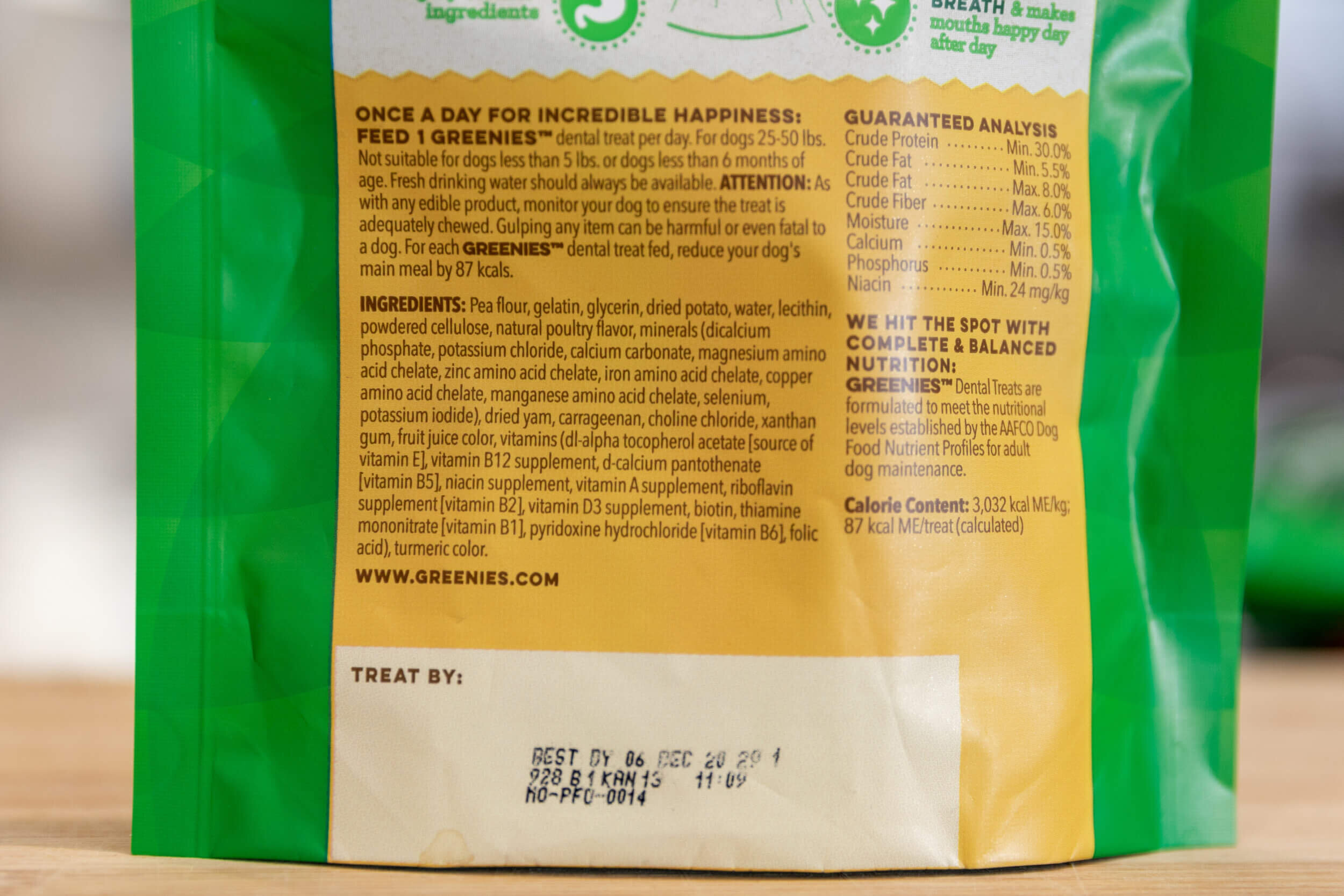
Pea Flour
Consumers havebecome savvier and more informed about the ingredients they are giving their pets.
Many are refusing to buy products with ingredients such as meals, by-products, and cheap fillers.
To replace these lower-quality products, things like grain-free pet products have grown in popularity.
Because of this, pet product manufacturers have been looking for ways to replace those cheap fillers and grains that consumers have identified as undesirable with something more appealing.
So, what did those manufacturers do?
They took out the cheap grain fillers (previously wheat flour and wheat gluten in the original Greenies) and replaced them with pea flour and pea protein (another cheap filler).
The marketing team slapped a grain-free label on their new product and started pushing it out to retailers nationwide.
Dont believe me?
Check out this Original Greenies ingredient label (below) and compare it with the Grain-Free one (above).
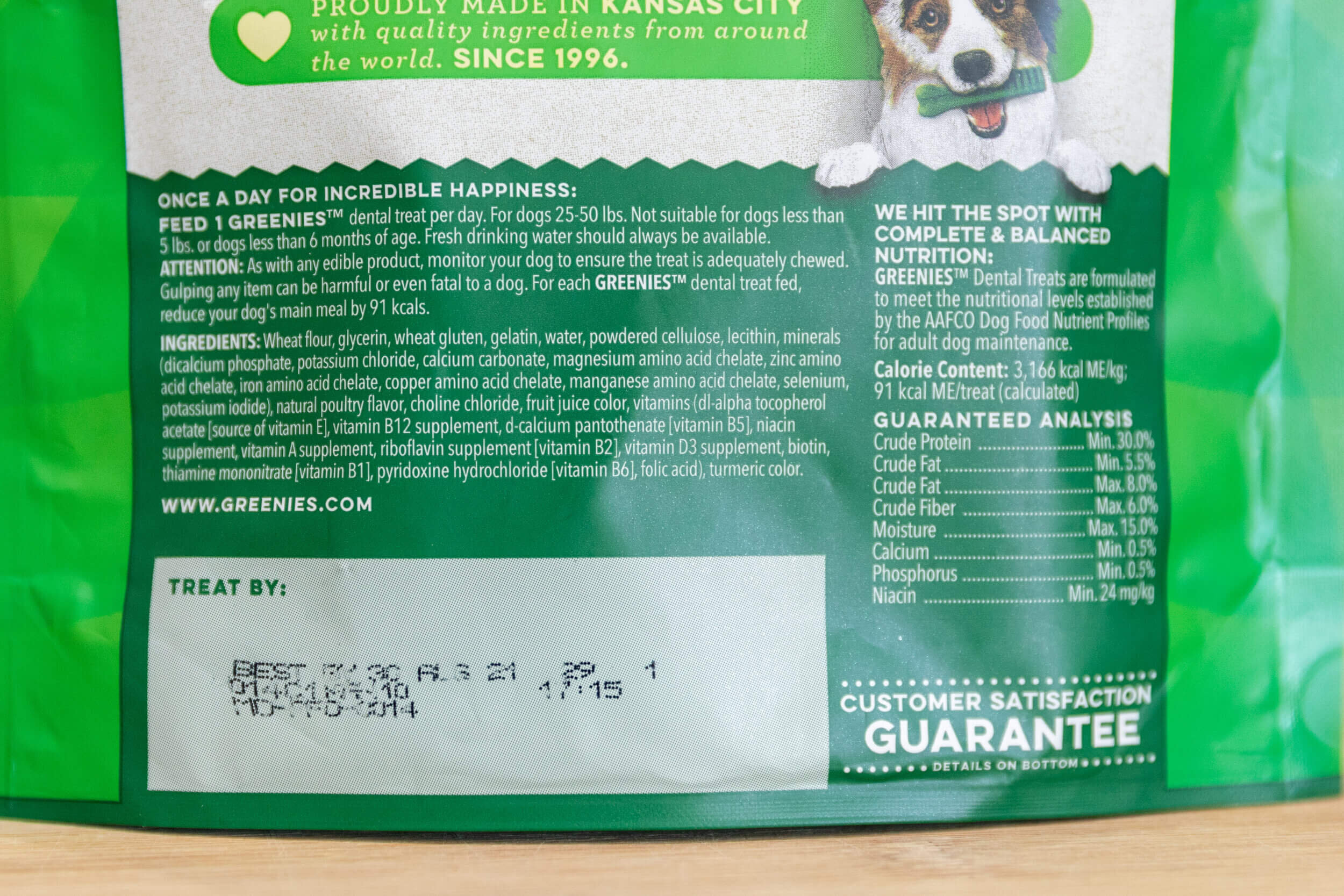
Why is pea flour/pea protein bad for my dog?
It is important to understand that pea protein is avegetable protein, not an animal protein.
Because of this, pea protein is harder to digest for dogs.
Your dogs body wont be able to break down and absorb all of the protein they are consuming.
So, most of the protein they are consuming is wasted.
Pea flour isnt just a bad source of protein, it is also full of carbohydrates.
When digested, the carbohydrates found in pea flour are broken down into sugars in the mouth which fuel plaque and tartar build-up on your dogs teeth.
Pea flour is nothing more than a cheap filler disguised as a protein that actually makes your dogs dental health worse.
So, why is it found in your dogs chew?
Manufacturers add pea protein to artificiallyinflate the protein percentages in grain-free pet products.
The protein found on the label is not the actual amount of protein that your dog is able to digest and use.
The remaining undigested protein serves no purpose for your dog, no nutritional value, and will eventually leave your dogs body as waste.
You wont find pea fiber in high quality commercially available pet foods, nor will you find it in healthy recipes for homemade pet meals. Where you will find it is in very affordable, highly processed, low-quality pet food, saidDr. Karen Becker, DVM
Once again, pet product manufacturers have found a new way to trick pet parents into thinking their products are better and healthier than they actually are.
Gelatin
Gelatin isnt a horrible ingredient for your dog to consume. Actually, it can be quite beneficial (assuming its sourced safely and naturally).
Gelatin comes from collagen which is rich in animal protein and amino acids.
Greenies manufacturers add it as a gelling agent which causes their product to be gummy and chewy.
You can provide your dog with a natural source of gelatin by feeding bone broth (which you can make at home).
Glycerin
If your dog has ever had an upset stomach after consuming Greenies, then glycerin is likely to blame.
Glycerin is a form ofsugar alcoholthat dogs (and humans) cannot fully absorb. It offers the same nutritional benefits as sugar, with even more calories.
Glycerin attracts water like a sponge. When consumed, glycerins moisture-attracting properties pull water from the body into the colon, acting as a laxative and stimulating bowel movements (i.e. gas and diarrhea).
If diarrhea wasnt bad enough, the sugar in glycerin is also very bad for your dogs dental health. The high carbohydrate content directly fuels plaque and tartar build-up, further worsening the overall health of your dogs teeth and gums.
So, why is it found in your dogs chew?
Because glycerin has that moisture-attracting property we talked about earlier, adding glycerin to foods helps them stay moist.
Generally speaking, glycerin is widely used in food manufacturing as a preservative.
Although glycerin helps the manufacturer control the moisture content in their product, it offers no nutritional benefit to your pet.
It is just a moisture-absorbing sugar.
Dried Potato
Dried potato is another starchy filler that is very similar to pea flour. It offers little nutritional benefit for your dog.
Just like glycerin and pea flour, the carbohydrates found in potatoes also break down into sugars that fuel plaque and tartar build-up.
This actually works AGAINST your dogs teeth and gum health.
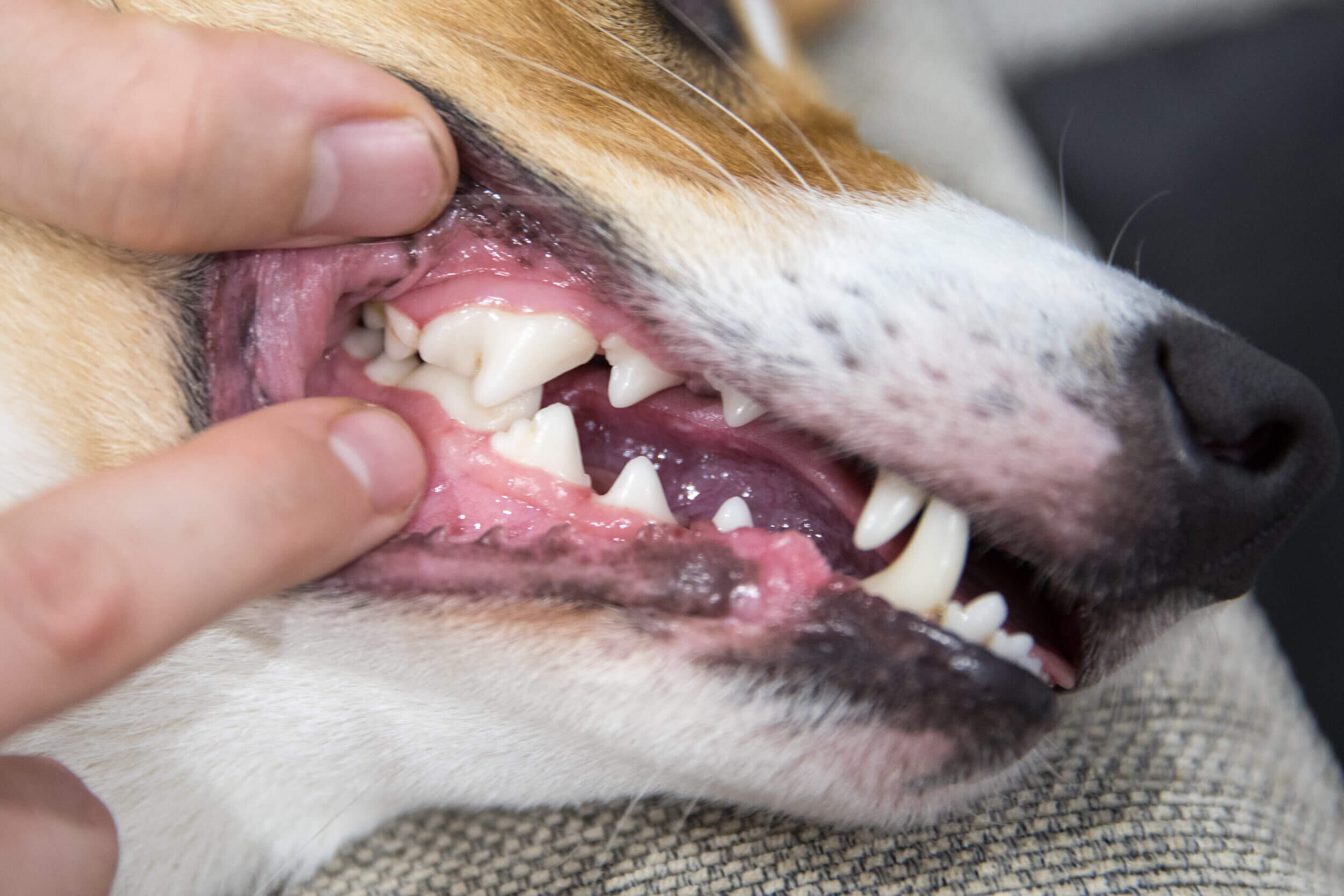
Alternatives To Greenies Dog Treats
Unfortunately, Greenies success is likely the result of well-designed packaging and clever marketing. Not because their product is of high quality.
Now, just because Greenies for dogs are off the list, that doesnt mean you are out of options.
There are lots of other safe and healthy for you to give your dog.
Here are 5 ways you can control, reduce, or eliminate plaque and tartar in your dogs mouth:
1.Healthy Diet
The foundation of a healthy mouth starts with a healthy diet.
It is important to avoid foods with highly processed ingredients such as corn and potatoes.
Bacteria are known to thrive on carbohydrates (namely sugar and starches).
So, when your dogs food gets stuck in their teeth, it provides a place for plaque to feast and tartar to develop.
By feeding your dog a balanced, high-quality diet, you can drastically reduce the risk of canine periodontitis developing.
2.Chewing
When you are looking for products to give your dog to promote dental care, I recommend looking for single ingredient products.
I typically recommend products like bully sticks or beef tendon.
These products offer the same benefit as mechanical chewing: clean teeth freshen breathe, and healthy gums.
Without contibuting to the problem with filler ingredients which feeds dental disease.
Along with providing single-ingredient chews, It is important that you continue to regularly brush your dogs teeth to prevent canine periodontitis.
Avoid These Chews
- Greenies Dog Treats
- Flavored Dental Chews (Like Dentastix)
- Antlers, Horns, Hooves
- Himalayan Yak Chew
- Nylabone/Benebone
- Rawhides
Give These Chews Instead
- Beef Pizzle (Bullysticks)
- Pig. Lamb, or Cow ears
- Duck or Chicken Feet
- Beef Tendon
- Beef Trachea
- Turkey Necks
Always supervise your dog when they are chewing. All chews are choking hazards.
These alternative chews can typically be found at your local ethnic food store or butcher shop.
The key to success is to find a single-ingredient chew that is not heavily processed and has little to no carbohydrates or sugars.
There are also companies like Farm Hounds that deliver natural single-ingredient dog treats and chews straight to your door.
You can make individual purchases, or they offer a convenient monthly subscription box service.
3.Meal Additives
A great way to combat plaque is to stop it at the source by using a meal additive such asPlaqueoff(or kelp/seaweed).
Plaqueoff is made from 100% natural seaweed which has been shown to significantly reduce plaque and tartar build-up in dogs.
It inhibits the plaque from sticking to surfaces in the mouth as well as softens the already existing tartar.
Solutions like additives dont work overnight but improvements should be seen anywhere from 3 to 8 weeks.
4.Brushing
We all know that the best way to clean teeth is to brush them. After all, isnt that how we clean our own teeth? Ideally, a dogs teeth should be brushed twice a day.
Homemade Doggy Toothpaste
Baking Soda (2 tbsp)
Coconut Oil (2 tbsp)
Peppermint Oil (1 drop)*optional
5.Dental Cleanings
For many dogs, periodontal disease has already set in under the gum line and no amount of brushing, chewing, or meal additives will help.
At this point, it is best to take your dog in for an oral exam, x-rays, and cleaning with a licensed veterinarian.
There are always risks associated with anesthesia, but the risks of canine periodontitis far overshadow the risks involved with anesthesia.
If a vet recommends a dental cleaning for your pet, it is always in their best interest to get one done.
Final Thoughts
There is no room for excuses!
It is time to throw that box of Greenies away and make the switch to single-ingredient chews that are actually going to improve your dogs dental health long term.
Many pet product manufacturers have caught on to the fact that their consumers are becoming more educated and aware of the products they are buying.
In turn, manufacturers have learned how to present their products as seemingly healthy by using terms like, high-protein, grain-free, and all-natural.
For things like dental chews, you should always strive to stay away from products that have sugars and carbohydrates and instead look for single-ingredient chews that are not processed or bleached.
In the end, chewing and gnawing are only part of the dental health solution.
The Great Greenies Debate: Unwrapping the Controversy
Welcome, fellow pet enthusiasts and curious minds! Today, were diving deep into the world of pet dental care, specifically focusing on one of the most debated products in the pet industry: Greenies. Youve probably heard of themthose green, toothbrush-shaped treats dogs and cats go wild for. But behind the enthusiastic crunching, theres a whirlwind of controversy were here to unpack.
Charting the Controversy
Dental Delight vs. Danger
| Factor | Pros | Cons |
|---|---|---|
| Dental Health | Reduces tartar build-up | Misleading benefits for some pets |
| Digestibility | Highly digestible when chewed properly | Risk of blockages if swallowed whole |
| Ingredients | Made with natural ingredients | Potential allergens for some pets |
Popularity Trends vs. Reported Incidents
| Year | Popularity among Pet Owners | Reported Incidents |
|---|---|---|
| 2019 | High | Low |
| 2020 | Higher | Moderate |
| 2021 | Skyrocketing | Increased |
The Meat of the Matter: Navigating the Debate
The Chewy Truth
Greenies are designed to combat plaque and tartar, promoting dental health. Many pet owners report significant improvements in their pets breath and dental hygiene. However, the size and chewing habits of your furry friend play a pivotal role in the effectiveness and safety of these treats.
A Bite-Sized Warning
Not all tails wag the same way, and similarly, not all pets can handle Greenies alike. Cases of gastrointestinal blockages have been reported, predominantly when pets have swallowed large pieces without proper chewing. This raises questions about suitability for all dog and cat breeds, sizes, and ages.
Ingredient Inspection
Made with natural ingredients and boasting a nutritious profile, Greenies seem like the perfect treat. Yet, for pets with specific allergies, they might be less of a treat and more of a threat. Its crucial to scrutinize the ingredient list for potential allergens to your pet.
The Enlightened Path: Tips for Pet Owners
Know Your Pet: Understand your pets chewing behavior and select the size and type of Greenie accordingly.
Supervision is Key: Always monitor your pet when theyre enjoying their treat to avoid any choking hazards.
Allergies Alert: Check the ingredients for anything your pet might be allergic to.
Balance is Best: Treats should not make up more than 10% of your pets daily calorie intake. Greenies are no exception.
Consult the Vet: When in doubt, your vet knows best. A quick consultation can save you a lot of worries.
Conclusion: To Chew or Not to Chew
In the great debate over Greenies, theres no one-size-fits-all answer. They can be both a boon and a bane, depending on individual circumstances. Armed with the right information and a keen eye on your pets reaction, you can make an informed decision. Remember, the ultimate goal is your pets health and happiness. So, chew over the information, consult your vet, and keep those tails wagging safely and healthily!
An Expert Dives Deep into the Greenies Dialogue
Interviewer: Welcome! Today, were peeling back the layers of the Greenies controversy. Weve got an expert with us whos ready to sink their teeth into the matter. Lets dive right in. First off, can you share your initial thoughts on Greenies?
Expert: Absolutely, and thank you for having me. Greenies sit at this fascinating intersection of innovative pet care and consumer caution. Initially designed as a dental health solution, theyve become a household name. However, like any product that gains rapid popularity, theyre scrutinized, and rightfully so. The first thing I think of is the balance they try to strike between being a treat and a health product.
Interviewer: Speaking of scrutiny, there have been reports of health incidents. How do you weigh the benefits against the potential risks?
Expert: Its a complex equation. On one side, we have numerous testimonials praising Greenies for transforming pets dental health, with visibly cleaner teeth and fresher breath. These are non-trivial benefits, given the commonality of dental issues in pets. However, the risk factor, primarily the potential for gastrointestinal blockages, cant be ignored. It emphasizes the importance of responsible pet ownershipknowing your pets chewing habits, supervising treat time, and choosing the right size of Greenie. The product isnt inherently risky; its the context of use that dictates safety.
Interviewer: Thats an insightful perspective. How significant is the role of ingredients in this debate?
Expert: Its pivotal. The ingredient list of Greenies is a double-edged sword. On the one hand, it boasts natural ingredients, which is a big plus for pet owners seeking wholesome options. Yet, the inclusivity stops there. Pets with specific dietary restrictions or allergies could have adverse reactions. This isnt unique to Greenies but is a broader industry issuecreating a product that caters to every pets needs is challenging. Transparency and education around ingredients become crucial here.
Interviewer: With those points in mind, how should pet owners approach Greenies for their pets?
Expert: Thoughtfully and selectively. The key is not to get swayed by marketing or hearsay but to understand your pets health, dietary needs, and behaviors. No two pets are the same; whats a miracle treat for one might be less suitable for another. Always introduce any new treat, including Greenies, gradually, and observe your pets reaction. And, as always, keep your vet in the loop. They can provide tailored advice that neither the internet nor the back of a treat package can offer.
Interviewer: To wrap up, what future do you see for products like Greenies in the pet care market?
Expert: The trajectory for Greenies and similar products is promising but calls for innovation and adaptability. As we become more aware of our pets health needs and as our pets continue to be integral family members, the demand for high-quality, safe, and effective pet products will only grow. The future lies in research, refinement, and perhaps a move towards more personalized pet care solutions. Products like Greenies have opened doors and started conversations; its now about how we evolve those discussions into actions that prioritize pet health and safety above all.
Interviewer: Thank you for such a deep dive into the world of Greenies. Your insights certainly give our readers a lot to chew on.
Expert: It was my pleasure. Heres to making informed choices for the health and happiness of our furry friends!
HELP US PUT FOOD ON THE TABLE

